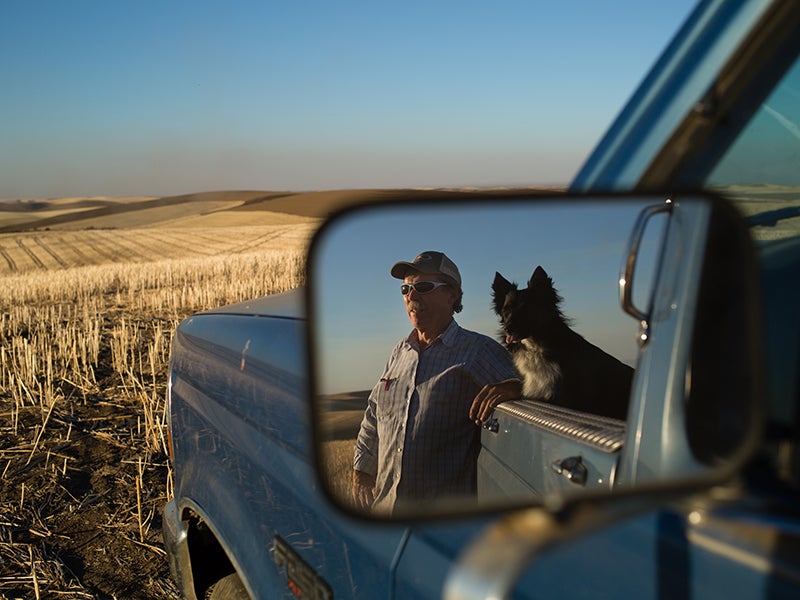With Shipping on the Decline, Opportunity Arises to Save Salmon
With more Washington farmers moving from barges to rail to ship crops, the call grows to remove dams on the Snake River and restore the dwindling salmon population.

This page was published 9 years ago. Find the latest on Earthjustice’s work.
It’s harvest time, and Bryan Jones’ farmhouse is filled with guests who have traveled to eastern Washington to lend a helping hand.
“We’re harvesting winter wheat,” he says.
It’s a hot, dry mid-July day. Thanks to extra sets of hands from family members, Jones guesses the wheat will be harvested in just a couple days. Soon after, they’ll start collecting the mustard crop.
Jones’ farm is located in the community of Dusty, partway between Spokane and Clarkston, in an open, hilly expanse of terrain where wheat fields extend out in every direction. Sheep wander the hillside trails, while a cluster of chickens, a rooster and a guinea hen named Casper strut outside a classic red barn. It’s an area so remote that neighbors must rely on one another for fire suppression—not an uncommon occurrence, as a stray spark from a portable engine can easily smolder in the dry grass. His is one of the few family farms still operating in the area, on land that’s been handed down for generations going back to 1868.
“With that comes some responsibility, and a connection to the nature of the place,” Jones says.
Just like the commercial farmers in his area, Jones relies on Snake River barges to move his grain to port. Historically he and others would send their crops to the inland port along the Snake River, where they would be ferried down to the Columbia River to Portland, Oregon. A series of dams, constructed in the ’60s and ’70s, transformed the free-flowing Snake into a glassy, slow-moving navigation channel. But the solution for farmers proved deadly to native populations of salmon and steelhead.
Millions of fish once followed natural migratory routes toward spawning grounds, but populations have crashed since the dams’ construction. This summer, about 35 percent of the Snake River sockeye salmon run died migrating upriver. Scientists have said that removing four dams on the lower Snake is the best way to ensure the species’ survival. Thanks to an Earthjustice lawsuit, environmental advocates have the means to convince federal agencies to remove the dams and get the Snake River flowing again.
Until recently, Portland was the last stop for many goods slated for international shipment. But things have rapidly changed. This past May, the last major international shipping line made its final call to Portland, signaling the end of direct shipment to destinations such as Japan and Korea. River shipment is no longer a viable option from growers of crops like lentils and garbanzos. Service to the Port of Lewiston came to a complete standstill in 2015 when container shipping ended.
Linwood Laughy, an Idaho native and co-founder of FightingGoliath.com, chronicled the downturn of Snake River barging in a recent essay.
“Total freight volume on the lower Snake over the past 15 years has declined by 70 percent,” he wrote. “Barges no longer transport lumber or paper. Container shipping has declined by 99 percent….Even grain, virtually the only commodity still shipped on the lower Snake, has dropped by 37 percent since 2000.”
Laughy also pointed out that “almost all imports, such as chemicals for making paper and fertilizer, arrive by rail….The Snake River falls into the Corps of Engineers’ category of a waterway ‘of negligible use.’”
Jones, who takes environmental stewardship seriously, supports the restoration of a free-flowing river, but he says farmers’ needs have to be factored in, too.
“If I were to promote losing barging, I need to have another way to ship my grain,” Jones says. “Rail is the easiest and most obvious method.”
As a kid, Jones took trips to Penawawa, a community on the banks of the Snake near his farm where growers raised peaches, cantaloupe and watermelon.
“We’d have peach fights,” he remembers, laughing.
Removing the dams would allow those agricultural lands to prosper again. It would also save wild salmon by opening up more than 5,000 miles of natural habitat, and it would set in motion the largest watershed restoration project ever attempted.
“The Snake River is the only place,” Jones says. “It’s the one avenue we have for Snake River salmon to spawn.”